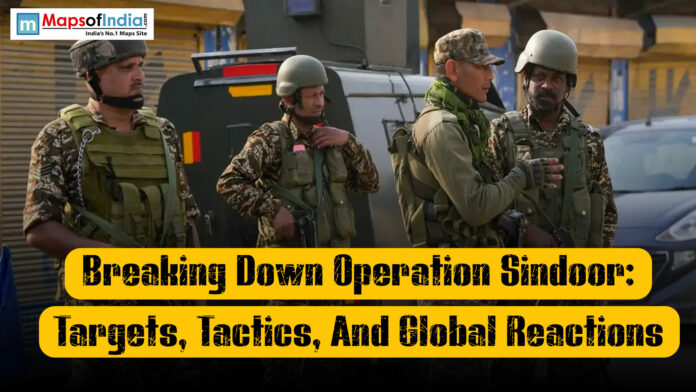Breaking Down Operation Sindoor: Targets, Tactics, and Global Reactions
On May 6-7, 2025, India conducted *Operation Sindoor, a robust military operation to strike at the terrorists hideouts in Pakistan and Pakistan-occupied Kashmir (PoK). The action was in response to the **Pahalgam tragedy* on April 22, 2025, where the Pakistan-based terrorist groups *Lashkar-e-Taiba (LeT)* and *Jaeish-e-Mohammed (JeM)* killed 26 people, the majority of whom were tourists. The operation was named *Sindoor* to mark the death of the victims, particularly represented by an image of a grieving widow, her red vermilion smeared. It was designed to demonstrate India’s intent to confront terrorism. Here is the complete story, classified to highlight key features.
What Was The Trigger For Operation Sindoor
The *Pahalgam attack* horrified India. Pahalgam is a scenic location that’s popular with tourists as a destination in Jammu and Kashmir (J&K). On April 22, 2025, terrorists from LeT and JeM killed 26 civilians, including Navy officer *Vinay Narwal, and his wife. A viral image that showed a closely-cropped photograph of the grieving widow, with smeared sindoor, became a symbol of the tragedy and outrage. In the aftermath, Prime Minister **Narendra Modi* ordered the government to take decisive action and identified it to as *Operation Sindoor* to reflect the heavy human toll and India’s desire for justice against terrorism. Also, Foreign Secretary *Vikram Misri* labelled it a “big reply” to cross-border terrorism, pronouncing India’s zero tolerance policy.
Who India Targeted
Operation Sindoor targeted *nine major terrorist hideouts, associated with **Jaish-e-Mohammed (JeM), **Lashkar-e-Taiba (LeT)* and *Hizbul Mujahideen*. These locations included targets in Pakistan (Bahawalpur, Muridke, Sialkot), as well as targets in PoK (Muzaffarabad, Kotli). The targeting of the hideouts was based on intelligence to strike specifically at terrorists’ operations without hitting civilians.
Important Targets
– *Bahawalpur (JeM Headquarters): The **Markaz Subhan Allah* in Bahawalpur, Pakistan’s Punjab province, was JeM’s engine of logistical, training, and operational planning for attacks like Pahalgam and the 2019 Pulwama bombing. The best of JeM’s henchmen, at least two of them related to JeM chief *Masood Azhar*, were instructed at the camp.
– *Muridke (LeT Stronghold): The **Markaz Taiba* was 200 acres of property 40 km from Lahore, Pakistan, and was the ideological and operational position of LeT. LeT was responsible for the attacks, the 2008 Mumbai Attack included LeT’s full infrastructure of training terrorists. Markaz Taiba was destroyed from Indian intelligence (RAW), crippling LeT’s operational capacity and intent.
– *PoK Camps (Muzaffarabad, Kotli): There were camps like **Syedna Bilal* (JeM), *Shwawai Nalla* (LeT) and *Makaz Raheel Shahid* (Hizbul Mujahideen). They were set up and came across as civilian facilities, but they were terrorist training facilities. Often, Pakistani military facilities were located beside these camps.
– *Sialkot (Hizbul Mujahideen): The **Mehmoona Joya* training camp was exclusively training people to attack Kashmir, supported by local networks.
India’s intelligence, *Research and Analysis Wing (RAW), had followed, tracked, and located record of the target hideouts. All the information was recorded over numerous surveillance runs before implementation of the strike. **Wing Commander Vyomika Singh* emphasized that the strikes avoided civilian infrastructure, targeting only terrorist facilities. The operation reportedly killed *10 family members and 4 aides* of JeM chief Masood Azhar, significantly weakening the group.
How India Carried Out Operation Sindoor
Operation Sindoor was a highly planned, *25-minute operation* (1:05–1:30 AM, 7 May, 2025) consisting of the *Army, **Navy, and **Air Force* ability to operate cooperatively as a single military. Conducting a military operation in *darkness* not only gives a tactical advantage over the enemy but also allows for more precision. The Indian military tried to maximize a high degree of precision with advanced technology while avoiding escalation with Pakistan’s military.
Tactics and Technology
– *Precision-Guided Missiles (PSWS): The Indian Air Force (IAF) took advantage of **Pinpoint Strike Weapon Systems*, using GPS and laser guidance precision to hit a designated target while having little collateral damage to the surroundings.
– *Loitering Munitions (Kamikaze Drones)*: India utilized Square Pegasus 360 robots and drones for the first time so the IAF and Indian Army could literally loiter above rugged Pakistani occupied territory (PoK) and strike precision targets with mobility. The “suicide drones” were intended to target inaccessible camps.
– *Night Raids*: The timing was deliberate, with three nebulous lines marking 1:05 and robustness for the head of the Pakistan Army. While the Pakistani military was unprepared for the pre-dawn strikes, the lack of air defenses is reportedly because of the Chinese made air defense systems used by Pakistan that could not respond. The operation reveals the inheritance of unpreparedness of Pakistan’s army.
– *Tri-Service Coordination*: Using Tri-service integration to conduct an intelligence-based military operation is impressive. During the 1971 war, India’s armed forces displayed tactical proficiency in a regional conflict – great to see integrated joint forces on a complex strike over land, sea and air strikes.
The successfully carried out strikes achieved their objectives with the destruction of all nine target sites – with an estimated *80–90 terrorists* killed, and *25–30 terrorists each* at Bahawalpur and Muridke, but not attacking Pakistan military installations nor Pakistan Army because of the escalatory situation. Video footage of the strikes was presented by *Colonel Sofiya Qureshi*. Thei Indian Army X post remarked that, on the #PahalgamTerrorAttack Justice is Served. Jai Hind!.
Global and Domestic Reactions
Operation Sindoor had mixed reactions around the world and a unified underscoring of support within India. The findings of this operation were widely disseminated on social media, further emphasizing the responses of support.
Supporters
– *Israel*: complimented India’s right to self-defense, parallel to its own efforts in the realm of counter-terrorism.
– *Indian Leaders: Defence Minister **Rajnath Singh* and UP CM *Yogi Adityanath* hailed the operation, emphasizing slogans of terrorism, “Bharat Mata Ki Jai!” And different opposition leaders including *Rahul Gandhi* and *Mallikarjun Kharge* sympathized with the armed forces. Regional leaders of instance *Omar Abdullah* and *Asaduddin Owaisi* similarly complimented the precision involved.
– *Victims’ Family*: Reassured to some extent, families such as Ms. Jagdale and Kaustubh Ganbote expressed thankfulness to the operation with a feeling that it eased their loved ones.
Critics and Neutrals
– *United States: President **Donald Trump* who spoke of the India-Pakistan conflict system as being “old” and suggested that both countries de-escalated tensions, was neither supportive nor critical. *Secretary of State Rubio* said they were actively monitoring developments.
– *China*: condemned the strikes, called for restraint. To some degree this was due to embarrassment that Pakistan’s Chinese-made air defense had failed.
– *Pakistan: PM **Shehbaz Sharif* said it was “blatant act of war” and reported 26 civilians had died, while India rejected the claims and stated there had only been terrorist-focused operation and were fully focused on target supply only. Other nations reportedly closed airports temporarily and authorized a military response. While tensions were rising. .
Social Media Buzz
Social media was abuzz with Pride in India but, fake videos circulated in Pakistan claiming retaliation, including an attack on the Srinagar Airbase, which Citizens Against Fake News debunked as recycled footage from 2024. India released its first official videos of the strikes, underscoring its commitment to transparency.
Importance of Operation Sindoor
Operation Sindoor represented a complete redefinition of India’s counter-terror strategy, the implications of which will last for years:
– *Proactive Stance*: India went from taking restraint further than most states, to striking deep inside Pakistan that makes clear that it will target terrorists wherever they are, and has moved beyond the 2016 Uri and the 2019 Balakot operations.
– *Technological Superiority*: The drones’ use, as well as precision missiles, also laid bare Pakistan’s weakness in its defensive posture, especially given the ongoing US/Western support for India’s technological advances.
– *Economic and Security Arrangements*: The Rupee dropped to 84.66 against the USD, but the markets settled down. Security exercises were conducted nationwide and schools were closed in border areas due to the increased status for safety.
– *Global Outreach*: With its diplomatic outreach to the U.S., the U.K., Russia and others about its capabilities, India presented itself to be a responsible actor, not withstanding any ongoing threats from Pakistan and criticisms from China.
Analyst *Happymon Jacob* has noted on X that the operation “turned the game on its head,” establishing a new normal for bilateral relations between India and Pakistan.
The Heroes of Operation Sindoor
The operation memorialized the *26 Pahalgam victims. The name **Sindoor* affirms their individual tragedies, most especially the widows. The military leadership of *Colonel Sofiya Qureshi* and *Wing Commander Vyomika Singh* contributed in bringing the nation to action, with clarity as their weapon. PM Modi’s edict—“Terrorists will be caught no matter where they hide”—encouraged the country to act. The bravery and precision of the tri-services inspired admiration throughout the country. The families of the victims were able to take some comfort in knowing justice had been served.
Conclusion
Operation Sindoor signaled India’s authoritative response against terrorism. It was a precise, brave and humane operation. Targeting nine terrorist killings in 25 minutes, India was able to avenge the Pahalgam killings but also show restraint towards escalation. In the face of threats from Pakistan and disapproval from China, it was India’s strategic and technological advantages that prevailed, bringing the country both unity domestically and targeted support internationally. Operation Sindoor will be seen as a watershed moment, demonstrating India’s unwavering commitment to protect its people and impose costs on terrorist organizations.




